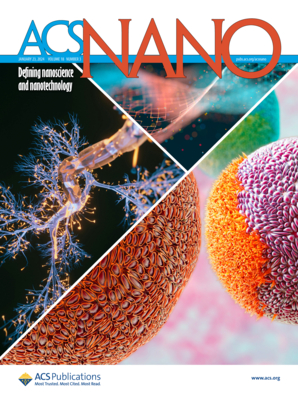IF 15.8
1区 材料科学
Q1 CHEMISTRY, MULTIDISCIPLINARY
引用次数: 0
摘要
治疗性过敏原疫苗免疫原可引发 IgE 介导的肥大细胞活化,从而导致过敏反应。在这里,我们报告了一种低过敏性免疫原设计模式,通过优化表位之间的距离,实现针对 IgE 反应肽 B 细胞表位的免疫。通过使用基于 DNA 的模型免疫原,我们发现肥大细胞和 B 细胞对表位间距的敏感性各不相同,高表位间距会抑制肥大细胞的活化,而 B 细胞对相同的免疫原配置仍有反应。为了利用这一发现,我们构建了基于表位密度超低的超分子肽纳米纤维的低过敏性免疫原,将其用作过敏原疫苗时,可提高保护性过敏原中和 IgG 抗体反应。这项研究为基于纳米尺度控制 IgE 反应性表位之间距离的低过敏原免疫原设计模式提供了概念验证,它可以在不产生过敏反应性的情况下针对 IgE 反应性表位靶点接种过敏原疫苗。本文章由计算机程序翻译,如有差异,请以英文原文为准。

Differential Sensitivity to Interepitope Spacing in Mast Cells and B Cells Enables Design of Hypoallergenic Allergen Vaccine Immunogens
Therapeutic allergen vaccine immunogens can trigger IgE-mediated mast cell activation, resulting in allergic reactions. Here, we report on a mode of hypoallergenic immunogen design that enables immunization against IgE-reactive peptide B cell epitopes by optimizing the distance between epitopes. Using DNA-based model immunogens, we show that mast cells and B cells exhibit idiosyncratic sensitivity to interepitope spacing, with mast cell activation being dampened by high interepitope spacing while B cells remain responsive to identical immunogen configurations. To exploit this finding, we construct hypoallergenic immunogens based on supramolecular peptide nanofibers with ultralow epitope density that, when used as an allergen vaccine, raise protective allergen-neutralizing IgG antibody responses. This study provides a proof-of-concept for a mode of hypoallergenic immunogen design based on nanoscale control of the distances between IgE-reactive epitopes, which may enable allergen vaccination against IgE-reactive epitope targets in the absence of allergic reactogenicity.
求助全文
通过发布文献求助,成功后即可免费获取论文全文。
去求助
来源期刊

ACS Nano
工程技术-材料科学:综合
CiteScore
26.00
自引率
4.10%
发文量
1627
审稿时长
1.7 months
期刊介绍:
ACS Nano, published monthly, serves as an international forum for comprehensive articles on nanoscience and nanotechnology research at the intersections of chemistry, biology, materials science, physics, and engineering. The journal fosters communication among scientists in these communities, facilitating collaboration, new research opportunities, and advancements through discoveries. ACS Nano covers synthesis, assembly, characterization, theory, and simulation of nanostructures, nanobiotechnology, nanofabrication, methods and tools for nanoscience and nanotechnology, and self- and directed-assembly. Alongside original research articles, it offers thorough reviews, perspectives on cutting-edge research, and discussions envisioning the future of nanoscience and nanotechnology.
 求助内容:
求助内容: 应助结果提醒方式:
应助结果提醒方式:


